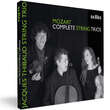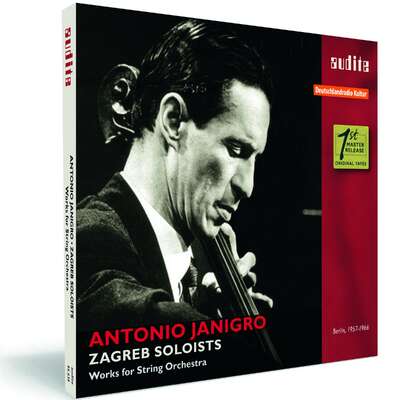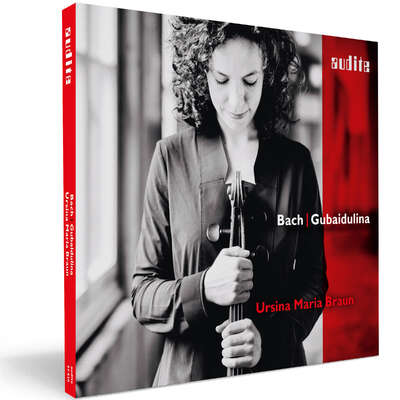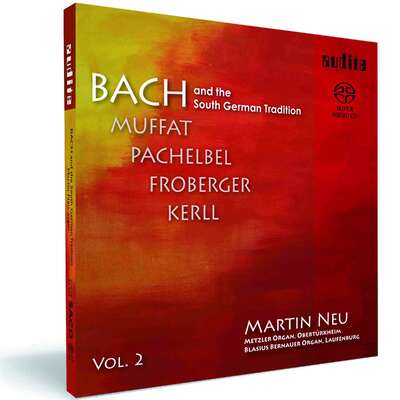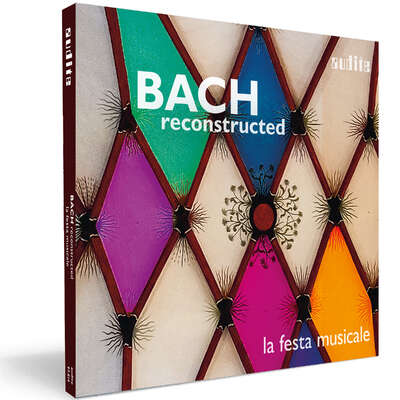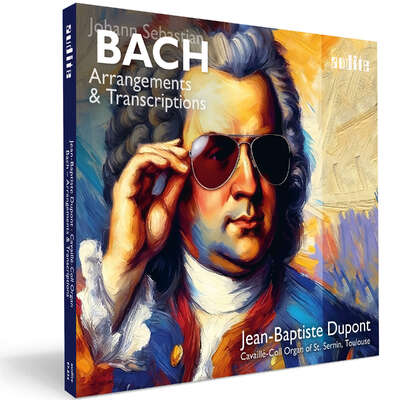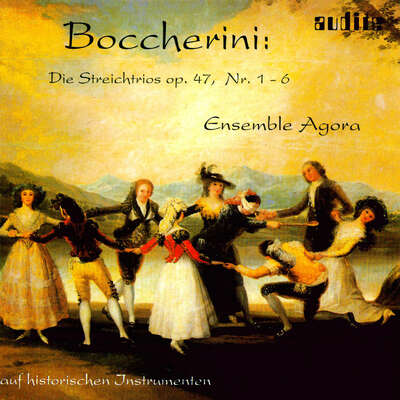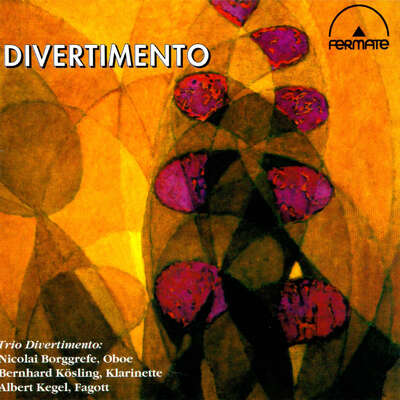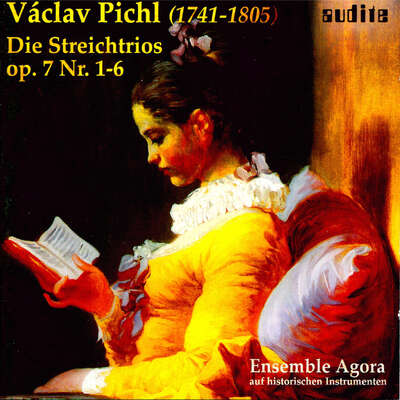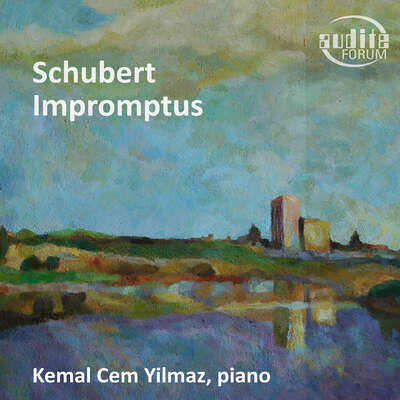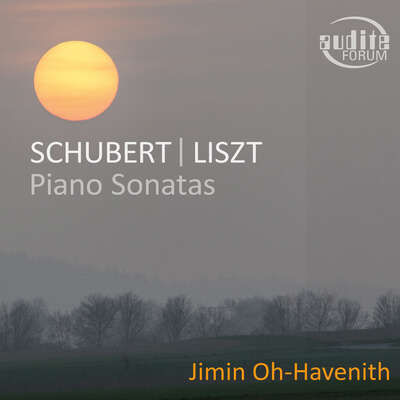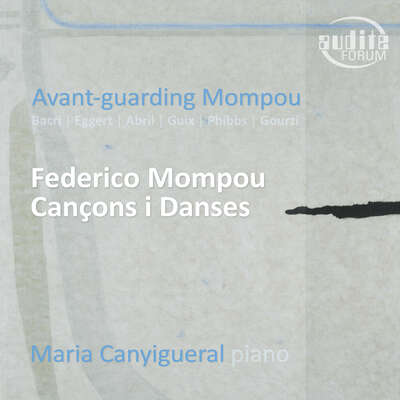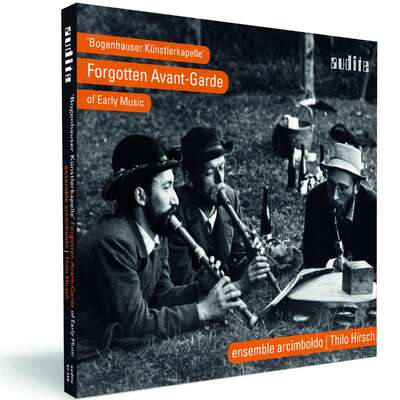
Auto-Rip
Mozarts sämtliche Werke für Streichtrio: Das Divertimento KV 563 ist Kammermusik von höchstem Anspruch, harmonisch reich und kontrapunktisch kunstvoll gearbeitet. An Virtuosität verlangt es den Interpreten Erhebliches ab. Die Sechs Adagios und Fugen KV 404a sind einzigartige Zeugnisse von Mozarts Beschäftigung mit dem Werk J.S. Bachs, was sein späteres Schaffen stark beeinflusste.mehr
"Das [...] Jacques Thibaud String Trio interpretiert die Adagios und Fugen sowie das Divertimento KV 563 mit Eleganz, Ausdruck und tänzerischem Schwung. Das Zusammenspiel der drei Streicher besticht überdies durch Präzision und Leichtigkeit." (Audio)
Titelliste
Diesen Bonustrack erhalten Sie ausschließlich als Download!
Details
| Wolfgang Amadeus Mozart: Complete String Trios | |
| Artikelnummer: | 97.773 |
|---|---|
| EAN-Code: | 4022143977731 |
| Preisgruppe: | BCA |
| Veröffentlichungsdatum: | 7. August 2020 |
| Spielzeit: | 93 min. |
Zusatzmaterial
Informationen
Mozarts sämtliche Werke für Streichtrio in der neuen Aufnahme mit dem Jacques Thibaud String Trio: Neben dem bekannten Divertimento KV 563 sind auch die Sechs Adagios und Fugen KV 404a komplett enthalten sowie das Fragment KV Anh. 66; Letzteres und Adagio und Fuga KV 404a Nr. 6 f-Moll sind als Download-Bonustracks gratis erhältlich.
Die Adagios und Fugen sind einzigartige Zeugnisse von Mozarts Beschäftigung mit dem Werk Bachs. In ihnen finden sich drei Fugen aus dem Wohltemperierten Klavier wieder, zudem jeweils eine Fuge aus der Kunst der Fuge und aus einer Orgelsonate sowie eine Fuge von Wilhelm Friedemann Bach. Vier langsame Einleitungen komponierte Mozart wahrscheinlich selbst, zwei langsame Sätze stammen wiederum aus Orgeltriosonaten von Bach. Mozart schrieb die Arrangements für die Sonntagsbesuche bei Baron van Swieten und wirkte bei den Aufführungen an der Viola selbst mit. Dass sich Mozart ganz bewusst an den „alten Meistern" schulte, hatte maßgeblichen Einfluss auf seine späteren Kompositionen.
Das sechssätzige Divertimento KV 563 von 1788 gilt als das Streichtrio schlechthin. Es ist Kammermusik von höchstem Anspruch, harmonisch reich und kontrapunktisch kunstvoll gearbeitet. Mozart verlangt den Interpreten hier noch deutlich mehr Virtuosität ab als in den Violinkonzerten oder der Sinfonia concertante KV 364 für Violine, Viola und Orchester. Im dreistimmigen Satz lotet Mozart erstaunliche Tiefen aus, Doppelgriffe ahmen zuweilen den Quartettklang nach, jedes Instrument übernimmt immer wieder die Führung - die Streicher agieren völlig gleichberechtigt, wobei Viola und Violoncello besonders dankbare melodische Aufgaben übernehmen. Das gesamte Potenzial des Streichtriospiels verdichtet sich in diesem großartigen Werk zu einem 50-minütigen Musikerlebnis im Mozart'schen Spätstil.
Besprechungen
Fanfare | February 2021 | Jerry Dubins | 1. Februar 2021
A year ago, in 43:3, I reviewed virtually this identical program, performed by the Ssens Trio, and gave it a rave review. This release by the JacquesMehr lesen
First, however, let me clarify why the two programs are virtually identical. Mozart transcribed for string trio five fugues by J. S. Bach and one by Wilhelm Friedemann Bach, prefaced four of them with Preludes of his own composition, and two of them with Preludes by their own composers. Here they are: [...]
The Ssens Trio included only the first three in the above table. The only reason I can think of for why is that they believed, or were told by their recording team, that there wasn’t enough space for more of them, even though the total timing of the disc ended up at just under 67 minutes. Here, the Jacques Thibaud Trio and their recording team found room for two more of numbers—4 and 5—for a total disc timing of 82 minutes on the nose. But there still wasn’t room for the last of them. However, Audite has made it available as a free download from its website, audite.de.
Now, to the differences between the two performances of the Divertimento. The Ssens’s approach is serious—scrupulous in its observance of the written notes and immaculate in its execution. The players genuflect in the presence of a masterpiece, perhaps the masterpiece of the string trio literature. It’s a divertimento in form—i.e., six movements with the customary two menuettos found in such works—but a string trio—i.e., violin, viola, and cello—in its instrumentation. It’s also a late work in Mozart’s canon, 1789, the same year that saw the composition of the Clarinet Quintet, K 581, and the antepenultimate string quartet, the No. 21 in D Major, K 575. These were works of a certain gravity, calling for readings respectful of their import.
But we don’t need Peter Shaffer and Miloš Forman’s movie, Amadeus, to know that up until his last days, Mozart could be a potty-mouthed cutup with a fun-filled zest for life. His association with Emanuel Schikaneder and the impresario’s folk theater tells us that, as does Mozart’s divertimento, Ein musikalischer Spaß (A Musical Joke), K 522, another relatively late work dating from 1787, and his funning around with Anton Stadler and the latter’s basset horns and clarinets. The Jacques Thibaud Trio hears Mozart’s string trio divertimento with different ears, ears that are attuned to a good deal of levity in the score, some of which, to be honest, I’d never really heard before.
I always knew that the theme and variations movement (4) was fall-down funny because I’ve played the work before. We even sang “Jack and Jill went up the hill ... ” to its side-slipping chromatic slithers. And its looney-tune, animated-cartoon finale was laugh-out-loud too. But I never thought the Menuettos could contain the giggles that the Thibaud players find in them. Listen to the little flip phrasings and portamentos that poke fun at the stylistic formalities, turning the aristocratic politeness into parody and caricature. Even the Adagio (2) and more so the minor-key variation in 4 are articulated with a crocodile-tears, faux-tragic expression that brings a smile to my face.
To achieve these effects and affects, the players do take liberties—a little rubato here, a stretched ritard there, inhaling pauses and exhaling sighs—but all of it conveys a sense of personal familiarity the players have with who Mozart really was. He wasn’t a carved alabaster figurine set upon an ivory pedestal. Perhaps more often than not, he could be that potty-mouthed cutup with a fun-filled zest for life depicted in Amadeus.
The Jacques Thibaud Trio has decided to have fun with the Divertimento, and, for me, it works wonderfully. I think I would sooner listen to this performance of the piece than I would any other; it’s irreverent and utterly delightful. The prize-winning Jacques Thibaud String Trio has been around since 1994. The ensemble has received worldwide acclaim, more than justified I would say based on this release. Among the ensemble’s previous albums have been a disc of string trios by Cras, Reger, Dohnányi, and Kodály, reviewed and recommended in 38:3 by Richard Kaplan, and a disc of trios by Milhaud, reviewed and recommended in 41:4 by Michael De Sapio. The Thibaud’s latest effort goes to the very top of my list. The best in virtuosity applied to the best in music-making.
American Record Guide | January 2021 | Joseph Magil | 1. Januar 2021
Mozart’s Divertimento K 563 is widely regarded as the finest string trio ever written. It is in 6 movements rather than the usual 4, and the titleMehr lesen
Fono Forum | Dezember 2020 | Gerald Felber | 1. Dezember 2020
Alle reden 2020 über Beethoven (oder über Corona) – aber hier wird ein Mozart geliefert, der den Bonner Querkopf sozusagen überspringt. DasMehr lesen
Hinzu kommen die mit viel Stilgefühl – des Komponisten und der Interpreten! – angelegten Bach-Bearbeitungen Mozarts, und weil die – auch klangtechnisch hervorragende, gleichermaßen körperhaft plastische wie durchsichtige – CD damit nach 82 (!) Minuten sozusagen bis zum überlaufen gefüllt ist, gibt's den Rest vom Label per Gratis-Download dazu: eine Gesamtschau mit Referenzcharakter.
Einwände? – Vielleicht wäre manchmal, zum Beispiel in den beiden Menuetten, dynamisch noch etwas mehr herauszuholen gewesen. Aber das grenzt schon an Nörgelei und darf nicht am Zugreifen hindern – denn was immer einer bisher von Mozart kennen mag: Ohne das Streichtrio weiß er noch nicht alles über ihn.
www.musicweb-international.com | Tuesday October 13th | Richard Hanlon | 13. Oktober 2020 | Quelle: http://www.music...
Mozart was admitted as an apprentice mason to the lodge known as Zur Wohltätigkeit (Beneficence) in December 1784; within months he would achieve theMehr lesen
The more familiar the Divertimento becomes the more it seems to creep up on one. It is neither recorded nor played especially frequently (Amazon lists 13 recordings although I suspect others are available as part of ‘complete works’ packages) but then it is a trio, and as such tends to be of interest to either scratch groups of star soloists or ensembles dedicated to the form, and they aren’t exactly thick on the ground. I seem to recall I received the Hyperion recording by the Leopold Trio (review) as a fortieth birthday gift what seems like aeons ago – I wasn’t a great Mozartean at the time and it gathered dust on my shelves for a good few years before a broadcast during a BBC lunchtime concert prompted me to give it a spin. I was soon hooked by both the piece and the marvellous recording (it was The Times ‘Disc of the Year’ in 2002) and have never felt the need to find an alternative.
Enter the Jacques Thibaud String Trio; their spirited yet extremely musical account has distinctive qualities and certainly dragged me out of my comfort zone. I’m familiar with a couple of their previous Audite discs of twentieth century fare (invigorating Milhaud and Martinu - review, and a collection of Reger, Dohnanyi, Kodaly topped by the magnificent, underappreciated trio by Jean Cras on AUDITE 97534) and their open-hearted, vivacious playing on those issues is present here in spades. In my experience the Audite engineers typically strive for a sound picture which leaves little to the imagination, a vivid, close-up image which in many cases approaches what one might hear in a live recital sitting close to the stage. It is an approach which can pay thrilling dividends (eg in the outstanding Mendelssohn cycle by the Mandelring Quartet (review) and in many of the Quartetto di Cremona’s fine Beethoven Quartet recordings). In terms of the present issue my initial impression on hearing the opening bars of the Divertimento’s initial Allegro was that the alpine freshness comes at the expense of domestic intimacy, especially compared to the Hyperion disc. But it’s extraordinary how quickly the ear adjusts and one settles back to enjoy the Thibauds’ scintillating, characterful playing. The beating heart of the work surely lies in the great second movement Adagio; I was aghast to find the Thibauds’ clip three and a half minutes off the Leopold’s timing for this panel – it certainly doesn’t feel too fast. In terms of comparing the two performances I suspect listeners’ preferences are more likely to be determined by the very different sonics – the exquisitely realised chamber mood of the Hyperion or the concert hall precision of the Thibauds. The latter are wonderfully lithe and mobile in the two Minuet movements whilst they find elegance and wit aplenty in the delicate intricacies of the theme and variations of the Andante that separates them. Their Allegro finale is robust and refreshing. If Mozart’s solo writing is unusually virtuosic for a string trio (as the booklet suggests) the Thibauds’ approach utterly eschews unnecessary showiness but retains a level of compulsive excitement. I was certainly glad to have made the acquaintance of this new reading of the Divertimento – although it is unlikely to displace the Leopold Trio’s account in my affection it offers a valid, bracing alternative. Perhaps one that’s better suited to the quality speakers in the living room, enabling the connoisseur to reserve the Leopold disc for cold winter West Pennine nights under the duvet with a decent pair of headphones and a tot of Jura.
The disc is entitled, rather grandly, Mozart’s ‘Complete String Trios’; in fact the coupling consists of five (out of a set of six) Adagios and Fugues K404a. These were among the fruits of Mozart’s intensive study of Johann Sebastian Bach’s fugues, investigations he conducted with his friend (another patron) Baron Gottfried von Swieten early in 1782. The first three feature Adagios of Mozart’s own devising, while the fourth and fifth Adagios and all five of the Fugues are basically three-part arrangements of Bach’s own music. Unsurprisingly the latter are drawn from the ‘48’ and ‘The Art of Fugue’. (A sixth Adagio and Fugue after Wihelm Friedemann Bach is available from Audite as a free download, together with an Allegro string trio fragment in G minor, identified as K 562e; I haven’t as yet listened to these). Whilst these pairings are far from insubstantial, they are but chippings from the master’s workshop in comparison with the mighty Divertimento; having said that they are perfectly satisfying in their own right and superbly played and recorded, an apt homage from one great master to another.
Norbert Hornig has contributed a most informative note for this issue which has been neatly translated. It completes a most generously filled issue replete with distinguished playing and sound.
Neue Musikzeitung | 8. Oktober 2020 | Michael Kube | 8. Oktober 2020 | Quelle: https://hoerbar.... HörBar
[...] das große Divertimento KV 563 erfordert einen anderen Zugang, einen eleganteren Ton, eine subtilere Kommunikation – Anforderungen, die das Ensemble mit seiner Erfahrung fraglos auf hohem Niveau erfülltMehr lesen
Audio | 10/2020 | Andreas Fritz | 1. Oktober 2020
KLANG TIPP
KLASSIK-HIGHLIGHT
Abseits der vielen Mozart-Hits bietet diese CD Aufnahme-Raritäten aus dem großen Oeuvre dieses einzigartigen Komponisten: Auch die StreichtriosMehr lesen
Stereoplay | 10|2020 | 1. Oktober 2020
KLANGTIPP
Kassizistische Klarheit
Unvertändelt lassen die Interpreten den Geist der Komposition leben: präzise in der Artikulation, gleichberichtigt in der Dreistimmigkeit, unzimperlich im Ton, elastisch in Dynamik und Phrasierung.Mehr lesen
Der neue Merker | 22.08.2020 | Alexander Walther | 22. August 2020 | Quelle: https://onlineme... Bewegende dynamische Momente
Das Jacques Thibaud Streichtrio lässt die kontrapunktischen und harmonischen Finessen dieser Werke in facettenreicher Weise Revue passieren. [...] Die Dreistimmigkeit wirkt dabei höchst transparent und ausgeglichen. [...] Insbesondere die Ausdruckstiefe [...] sticht leuchtkräftig hervor und berührt den Zuhörer. Mehr lesen
De Gelderlander | 22-08-20 | Maarten-Jan Dongelmans | 22. August 2020 | Quelle: https://www.geld... Mozarts hoge eisen zijn gesneden koek voor het Jacques Thibaud String Trio
Het bekende Jacques Thibaud String Trio speelt de Adagios und Fugen KV 404a als welkome aanvulling op het Divertimento in Es, KV 563 en zet daarmee eerdere uitvoeringen meteen in de schaduw. [...] Op sommige momenten krijg je als luisteraar het idee dat hier niet drie maar vier strijkers aan het werk zijn. Zo vol en intens is de klank. Typisch een album dat binnenkort in de prijzen zal vallen.Mehr lesen
www.pizzicato.lu | 07/08/2020 | Remy Franck | 7. August 2020 | Quelle: https://www.pizz... Mozarts Streichtrios
Mozarts Divertimento KV 563 und die Adagios und Fugen KV 404a nach Bach – die einzigen Werke, die Mozart für Streichtrio komponierte – hat dasMehr lesen
Die Thibauds bieten auch in den Adagios und Fugen nach Bach ein im Klang bestens ausgewogenes, nuanciertes und kunstvolles Spiel.
The Jacques Thibaud Trio has recorded Mozart’s Divertimento K. 563 and the Adagios and Fugues K. 404a after Bach – the only works Mozart composed for string trio. The three musicians play sonorously and rhetorically, but they also give the right place to the musical depth and wealth of ideas that fill Mozart’s late six-movement Divertimento, written shortly after his last three symphonies. The interpretation goes far beyond the purely entertaining character of the work that its title suggests. The Thibauds also offer in the Adagios and Fugues after Bach a well-balanced, nuanced and artful playing.
Stretto – Magazine voor kunst, geschiedenis en muziek | augustus 7, 2020 | Michel Dutrieue | 7. August 2020 | Quelle: http://www.stret... Uitermate verfijnd
Naast het bekend Divertimento, K. 563,staan op deze cd de 6 Preludes en Fuga’s van Bach, K. 404a, evenals het fragment K. Anh . 66 voorMehr lesen
In het Divertimento in Es, de toonaard met de symbolische drie bémols zoals in “De Toverfluit”, creëerde Mozart een meesterwerk, episch, fijn geproportioneerd en ernstig, maar toch gevuld met de ontembare humor van de componist. Hoe bescheiden de bezetting ook lijkt, de muziek is rijk aan stemvoering, compositorische inventiviteit en gevarieerd samenspel. Maçonnieke idealen en symbolische getallen zijn overal aanwezig. Mozart behandelde elk van de drie strijkers als de eerste onder zijn gelijken, nu eens als aanvoerder van de melodie, dan eens als begeleider, of samenspelend in duo, afwisselend met één van de twee anderen.
Mozart maakte zijn arrangementen voor private, zondagse bijeenkomsten in het huis van de Oostenrijkse diplomaat van Nederlandse afkomst, baron van Swieten (foto’s), waar hij de altvioolpartij speelde. Van Swieten stond nl. bekend als een groot en actief muziekliefhebber. Hij organiseerde op zondagochtend om 12 uur concerten in de bibliotheek (foto) of in zijn appartementen in hetzelfde gebouw. Hij was de stichter van de Gesellschaft der Associierten voor de uitvoering van oude muziek en oratoria en bestelde bij Mozart de bewerking van vier werken van Georg Friedrich Händel: Acis en Galathea, Messiah, Ode for St Cecilia’s day en Alexander’s Feast.
Hij liet Mozart, die hem steeds ‘Van Suiten’ noemde, kennismaken met de fuga’s van Bach. Mozarts vrouw, Constanze Weber (foto), was meteen verrukt van deze muziek en drong bij Mozart aan om ook fuga’s te componeren. Niet lang na het overlijden van Mozart kwam Van Swieten in diens gezinswoning langs. Hij regelde Mozarts eenvoudige begrafenis en verzorgde een voorziening voor zijn zoon om in Praag te studeren. Van Swieten organiseerde ook een van de eerste uitvoeringen van Mozarts Requiem in januari 1793.
Mozarts studie van de oude meesters zou een belangrijke invloed blijken te hebben op zijn eigen, latere composities. Het zesdelig Divertimento, K. 563, uit 1788 wordt beschouwd als hét strijktrio bij uitstek. Het is kamermuziek van de hoogste orde, met rijke harmonieën en zorgvuldig uitgewerkt contrapunt. Hier stelde Mozart hogere technische eisen aan de uitvoerders dan in zijn vioolconcerti of zijn Sinfonia concertante, K. 364, voor viool, altviool en orkest. Met slechts 3 partijen bereikte Mozart verbazingwekkend veel diepte, met dubbelsnaren die soms de klank van een kwartet imiteren. Alle drie strijkinstrumenten worden gelijk behandeld, elk op zijn beurt neemt het voortouw, en ook de altviool en de cello kregen bijzondere melodielijnen. Dit prachtig werk bevat het volledig potentieel van het strijktrio-samenspel.
De enige andere complete werken voor strijktrio van Mozart zijn de Preludes en Fuga’s (VIII, XIV en XIII) van Bach, die Mozart heeft getranscribeerd. Door drie preludes aan zijn Bach-arrangementen toe te voegen, bereikte Mozart een indrukwekkende symbiose tussen Bachs muzikale taal en zijn eigen stijl. Bachs invloed is overigens ook in het Divertimento te horen, vooral in de polyfonie van de mineur variatie van de Andante-beweging, een thema met vier variaties. De preludes en fuga’s zijn unieke documenten van Mozarts studie van Bach. Ze bevatten drie fuga’s uit het Wohltemperierte Clavier, een fuga uit Die Kunst der Fuge en een fuga uit een orgelsonate, en een fuga van Wilhelm Friedemann Bach. Vier van de preludes zijn waarschijnlijk van Mozart zelf, terwijl Mozart twee preludes uit Bachs triosonates voor orgel koos. De uitvoerders zijn Burckhard Maiss, viool, Hannah Strijbos, altviool en Bogdan Jianu, cello.
